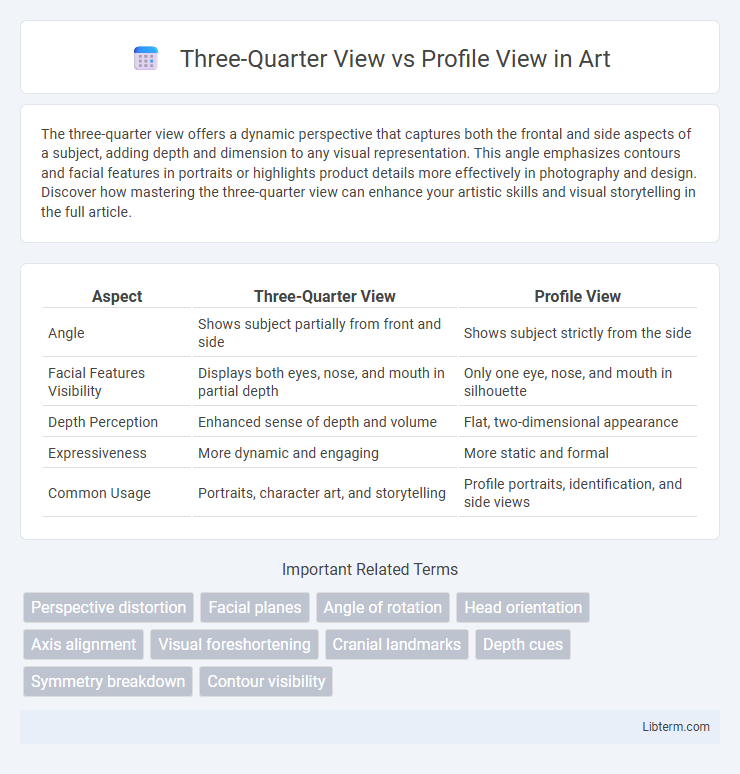The three-quarter view offers a dynamic perspective that captures both the frontal and side aspects of a subject, adding depth and dimension to any visual representation. This angle emphasizes contours and facial features in portraits or highlights product details more effectively in photography and design. Discover how mastering the three-quarter view can enhance your artistic skills and visual storytelling in the full article.
Table of Comparison
| Aspect | Three-Quarter View | Profile View |
|---|---|---|
| Angle | Shows subject partially from front and side | Shows subject strictly from the side |
| Facial Features Visibility | Displays both eyes, nose, and mouth in partial depth | Only one eye, nose, and mouth in silhouette |
| Depth Perception | Enhanced sense of depth and volume | Flat, two-dimensional appearance |
| Expressiveness | More dynamic and engaging | More static and formal |
| Common Usage | Portraits, character art, and storytelling | Profile portraits, identification, and side views |
Introduction to Portrait Perspectives
Three-quarter view and profile view are key portrait perspectives that define the subject's facial orientation relative to the viewer. The three-quarter view displays the face turned slightly away from full frontal, revealing more depth, facial structure, and a dynamic angle that enhances character and emotion. Profile view captures the subject's side silhouette, emphasizing the outline and contours of the face, often used to highlight features like the nose, jawline, and forehead in sharp detail.
Defining Three-Quarter View
The three-quarter view presents a subject's face turned midway between full profile and frontal view, revealing both the front and side features simultaneously. This perspective highlights the contours of the face, accentuating depth and dimension by displaying one eye fully and the other partially. Commonly used in portrait photography and character design, the three-quarter view offers a balanced and dynamic representation that captures more facial detail than a strict profile view.
Understanding Profile View
Profile view captures a subject entirely from the side, highlighting the outline of facial features like the nose, lips, and jawline in sharp silhouette, which is essential for emphasizing distinct contours and shapes. This perspective is frequently used in portrait photography and illustration to convey character, mood, and direction without distraction from frontal details. Understanding profile view aids artists and photographers in creating striking images that focus on the spatial relationship between facial elements and enhance narrative expression.
Visual Differences Between Views
The three-quarter view reveals more facial contours and depth by showing both the front and side of the face, emphasizing the nose, cheekbones, and jawline with partial shadowing. In contrast, the profile view displays only the side silhouette, highlighting the outline of the forehead, nose, lips, and chin without revealing facial symmetry or full features. These visual differences affect how expressions and character details are perceived, with the three-quarter view offering a more dynamic, dimensional perspective compared to the flat, linear profile view.
Artistic Applications of Each View
Three-quarter view offers artists the ability to capture depth and dimension, showcasing facial contours and expressions with dynamic angles ideal for portraits and character design. Profile view excels in highlighting the silhouette and structure of a subject, making it valuable for studies in anatomy, gesture drawing, and creating striking, minimalist compositions. Both views serve distinct artistic purposes by emphasizing different spatial relationships and emotional tones within visual narratives.
Impact on Facial Features and Expression
The three-quarter view emphasizes depth and dimension in facial features by revealing both the front and side of the face, enhancing the perception of contours and expressions like subtle smiles or intense gazes. In contrast, the profile view highlights the silhouette of the nose, chin, and forehead, offering a strong outline but limiting the visibility of nuanced facial expressions. This perspective shift affects emotional impact and character interpretation, as the three-quarter view conveys more dynamic emotion while the profile focuses on distinctive structural traits.
Historical Use in Art and Photography
The three-quarter view has been extensively utilized in classical portraiture, enabling artists like Leonardo da Vinci and Rembrandt to capture depth and facial complexity by revealing both the front and side of the subject's face. In contrast, the profile view, favored in ancient coinage and Egyptian reliefs, emphasizes contour and silhouette, serving symbolic and identification purposes. Photography inherited these conventions, with three-quarter portraits offering a dynamic sense of personality, while profile shots often highlight distinctive features or create a dramatic, timeless effect.
When to Choose Three-Quarter vs Profile
Choose a three-quarter view when you want to showcase depth and dimension, as it captures both the front and side of the subject's face, adding a dynamic and engaging perspective. Opt for a profile view to highlight the subject's silhouette and emphasize facial features like the nose and jawline, creating a strong and distinctive outline. Three-quarter views work well for portraits aiming to convey personality and emotion, while profile views are ideal for formal identification or artistic emphasis on the contour.
Tips for Drawing or Photographing Each View
When drawing or photographing the three-quarter view, emphasize capturing the subject's facial depth by highlighting the prominent cheekbone and the gradual contour of the jawline, ensuring the eyes remain well-aligned and expressive. For the profile view, focus on accurately defining the silhouette, paying close attention to the nose, lips, and chin's distinct shapes to create a strong and recognizable outline. Both views benefit from controlled lighting to enhance dimensionality and texture, with soft shadows accentuating facial features without obscuring key details.
Conclusion: Selecting the Right Perspective
Choosing between three-quarter view and profile view depends on the intended emphasis in visual representation; three-quarter view offers depth and dimensionality, highlighting facial features dynamically, while profile view provides clarity and detail of the side silhouette. For portraits requiring emotional engagement and realism, three-quarter view is ideal, whereas profile view suits contexts that demand clear outlines, such as identification or anatomical studies. Balancing artistic goals with communication needs ensures the selection of the most effective perspective.
Three-Quarter View Infographic

 libterm.com
libterm.com